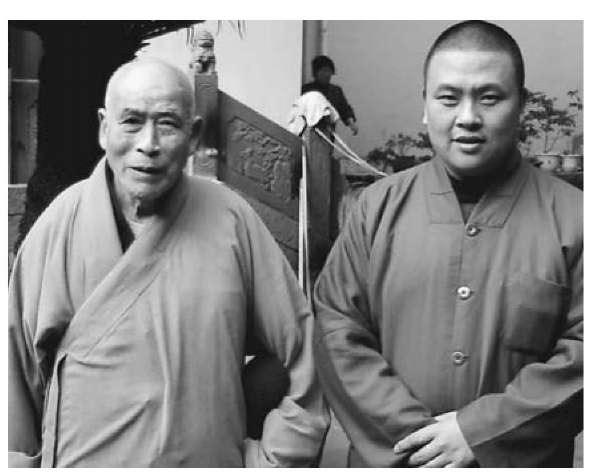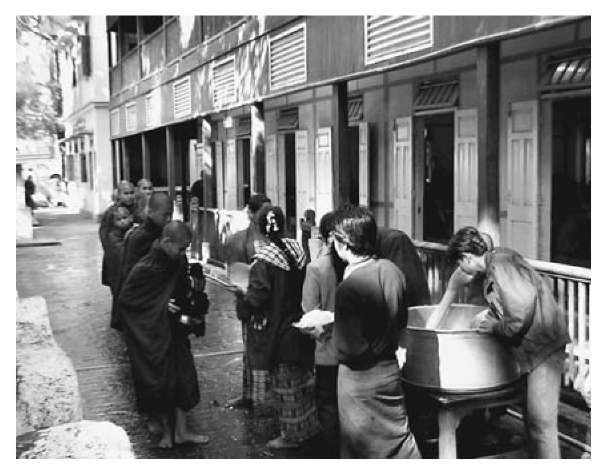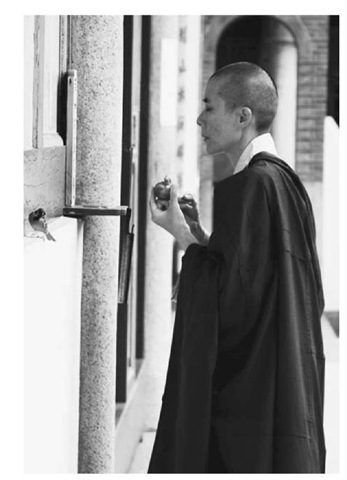Bhavana
Bhavana is a Sanskrit term for "dwelling," and, by extension, it evolved to refer to meditation. The meditator dwells in the state of meditative repose. The contemporary Theravada scholar Walpola Rahula contends that this key term is widely misunderstood. According to him, bhavana should indicate a mental culture in which the individual is on a complete path of purifying the self of mental illusions, all disturbances, and impurities. It should not simply be seen as a series of exercises or practices separate from other parts of life. Similarly, the Indian scholar Sikimar Dutt emphasizes the revolutionary impact of the Buddha’s message on the ancient Khmer peoples of Cambodia, who were used to living in a world where kings were gods and society was caste-based. According to Dutt, Theravada’s emphasis on bhavana, which he translates as "becoming," was a call for each person to develop self-knowledge and begin the path of self-cultivation.
Two generations of monks in a temple in Wenzhou, on China’s eastern seaboard
In general discussion today bhavana refers to Buddhist meditation practices. These are generally categorized into two types: samatha (tranquil-ity, calm) and vipassana (insight).
Bhiksu/bhikkhu
A bhiksu (in Pali, spelled bhikkhu) is one who begs for food, and in Buddhism the term therefore refers to a Buddhist monk. It is used throughout Buddhist literature for a follower of the Buddha who has taken the precepts, vows taken in an initiation ceremony. They are then considered members of the sangha, or monastic community. The vows, as spelled out in the Pratimoksa, or rules of monastic conduct, are fixed at 217. In the beginning ordination was informal, but as the sangha grew ordination became formalized and strict. All members of the sangha simply had to repeat the trisarana (Three Jewels) formula three times, and promise to follow the 10 vows. Monks later started as pravrajya (going forth), progressed to novice (sramanera), and once they were at least 20 were given full ordination in the upasampada ceremony. They traditionally possess only robes, an alms bowl, a razor, a needle, a staff, and a toothpick. Bhiksus were traditionally expected to beg for food and not maintain a fixed place of residence. Settled existence later became more common, in monasteries. Although Buddhist monks were not expected to work or marry, in some locations (China, Japan) they were allowed to work, and in some (Tibet, Japan) to marry.
Monks dressed in vermilion robes line up at the Magandha temple, outside Mandalay, northern Myanmar (Burma), to receive rice for their midday meal.
Bhiksuni/bhikkhuni
A bhiksuni is a female mendicant, a nun. In legend and the Buddhist canon the first bhiksuni was Mahaprajapati, the Buddha’s aunt and stepmother. The regulations for a bhiksuni are stricter than for a bhiksu (male monk). Bhiksunis must undergo a two-year probation if they had been previously married for more than 12 years or are less than 20 years old. The version of the Pratimoksa (rules of conduct) that applies to nuns has 100 more rules than the monks’. (The number of precepts for nuns varies slightly in the different Vinaya versions, totaling between 166 and 210.) And there are eight special rules, the gurudharmas, that confirm the nun’s secondary status in relation to monks. From the start, then, women were placed in a subsidiary position to men.
The details for bhiksunis’ ordination and precepts are found in the bhiksunivibhanga, part of the Dharmaguptaka Vinaya. The exact process of becoming a bhiksuni can be summarized as follows: There are three overall stages. First is going forth, pravrajya, followed by the two-year probationary period, in which the novice becomes a siksamana, and, finally, full ordination (upasam-pada). Going forth involves a ceremony of cutting the hair in which the assembly of nuns (bhik-sunisangha) is asked to cut the candidate’s hair, after which the candidate is also asked questions. The candidate then informs the assembly three times that she is taking refuge in the Buddha, the Dharma, and the Sangha (the Three Jewels) and thus becomes a sramanera (novice). She is then given the 10 precepts that will govern all bhiksuni, the dasa siksapadani. These include, in addition to the five precepts (pancasila) common to all Buddhists, proscriptions against wearing flowers, perfume, or jewels; singing, dancing, or making song; using a high or large bed; eating at the improper time (after noon); and keeping gold, silver, or other valuables.
Mahayana Buddhist nun
At the age of 18 the sramaneri (novice) is allowed to ask the assembly of nuns to be allowed to study the precepts and become a siksamana, a probationary nun. This is the intermediate stage between novice and full monk/nun status, a stage that is not required for males. After making the request to the assembly the candidate is led away and a spokesperson asks the assembly on her account whether they will accept the candidate. The accepted siksamana must follow the six (sometimes 18) rules. Probably the oldest version of these rules is found in the Pali Vinaya, which lists prohibitions on sexual intercourse, stealing, taking human life, and lying, plus eating after noon and drinking alcohol. Since all of these prohibitions were already mentioned in the dasa siksapadani (above), the difference between a sramaneri (female) or a sramanera (male) novice and a siksamana (nun probationate) is, apparently, a formal distinction only and probably simply implies a slightly higher rank. Regardless of status, both sramaneri and siksamana are expected to follow the rules for bhiksuni in general, with a few formal exceptions.
In the final stage of ordination a spokesperson (upadhayayini) is also required to speak on the candidate’s behalf before the assembly of nuns, the bhiksunisangha. in this case the candidate is also present. If the bhiksunisangha consents, the candidate, holding her robes and alms bowl, asks the bhiksunisangha three times for ordination. There is a public interrogation, and, if it is passed, the ordination ceremony. Two unique instructions are then given. First, the eight parajayika (from "disconnect" or "exclude") precepts are explained. These are prohibitions about sexual intercourse, stealing, taking human life, lying about one’s (spiritual) achievements, having physical contact involving any area between the armpit and the knee, being with a man alone and doing any of the eight "wrong" things, hiding serious offenses of another bhiksuni, and following a bhiksu who has been suspended. The second instruction gives the four supports (nisraya): the bhiksuni should dress in rags, rely only on donated food, not live at the root of a tree, or use medicine made from "putrid" components.
Interestingly, Mahaprajapti, the Buddha’s aunt, and her 500 followers completed ordination by accepting only the eight rules (gurudharmas). The Buddha confirmed these have the same validity as the longer ordination procedure.
Today nuns are ordained only in Chinese lineages; ordination was broken in the two other older traditions, both from Theravada, making them extinct. Therefore, Theravada nuns today often travel to China or Taiwan to complete ordination in the Chinese lineage.
Bhumi
The Sanskrit term bhumi literally means "earth, locality, situation, rank, stage." In Mahayana Buddhist teachings there are fifty-two stages, or bhumis, in a bodhisattva’s development toward Buddhahood. After completing the preparatory stages, the cultivator embarks on a voyage of cultivation of the first 10 bhumis, or the dasabhumi. There are several lists of these 10 stages. The most widely known are the 10 stages common to most Buddhist groups, including those of Mahayana as well as earlier schools. These 10 stages are spelled out in the Mahaprajnaparamita Sastra (Treatise on the Ferrying Across by Means of the Great Wisdom), a work attributed to Nagarjuna (but perhaps composed by Kumarajiva). They are the stages of dry wisdom (no Buddha truth introduced), embryo, the eight patient endurances, freedom from wrong views, freedom from the first six of the nine delusions in practice, freedom from the remaining three delusions, complete discrimination with regard to wrong views (the arhat stage), the pratyekabuddha stage, the bodhisattva stage, and Buddhahood.
The Mahayana also offers an additional version of 10 stages; the boddhisattva’s 10 stages as given in the Dasabhumika Sutra, the Sutra on the Ten Stages. The 10 are the conditions of being pramudita (joyful), "joy at having overcome the former difficulties and now entering on the path to Buddhahood"; vimala (immaculate), the stage of perfected moral discipline; prabhakari (radiance), involving the cultivation of patience leading to further enlightenment; arcismati (blazing), characterized by vigor and flowing wisdom; sudurjaya (hard to conquer), where meditation is used to master final difficulties; abhimukhi (face to face), achieving wisdom above conceptions of impurity and purity; durangama (going far beyond), with skill in means, proceeding beyond ideas of self; acala (immovable), attaining calm and unpertur-bedness; sadhumati (good thought), fine wisdom, knowing how to save others, and having the 10 powers; and, finally, dharmamegha, achieving the powers of the law cloud, absolute knowledge. The 10 Mahayana stages became associated with the respective 10 paramitas, or perfections.
Bhutan (Druk-Yul), Buddhism in
Druk-Yul (land of the thunder dragon) is a small country sandwiched in between India and China known to most of the world as Bhutan. Most of the people are ethnically Tibetan. As the area emerged out of the prehistorical era, it was a land dominated by the Bon religion, an indigenous shamanistic religion that also held sway throughout Tibet. As Buddhism began to infiltrate into the area, Bon incorporated various elements of Buddhist practice, but in the end it lost its primary place to Tantric (Vajrayana) Buddhism in the form of Drukpa Kagyu Tibetan Buddhism.
Drukpa, one of a number of subschools of the Kagyu Tibetan tradition, originated with Lingje Repe in the 12th century. Drukpa Kagyu quickly became the majority religion in Bhutan, but Bon retained a substantial following until the 17th century, when the country was united by Lama Ngawang Namgyal, who as the shabdrung held both spiritual and secular leadership roles. For over three centuries, the country was led by a lamist theocracy—political leadership by Buddhist clergy. In 1907, the structure led by the shabdrung was replaced with a secular monarchy led by Ugen Wangchurch. He established a national nine-member council, two of whom are appointed by the religious leadership. In addition many Buddhist monks are active in the national consultative assembly.
Bhutan maintains its Buddhist establishment, which serves approximately 75 percent of its 1.5 million citizens. However, approximately one-fourth of the residents of Bhutan are of the Butia people, who are traditionally Hindu. The majority of them continue to practice Hinduism with the government’s cooperation. The Buddhist-dominated government has instituted laws to prevent other religions from entering and establishing themselves in Bhutan.
Bi gu
Bi gu, the Daoist idea of not eating any of the five grains (wheat, barley, rice, millet, beans), is an old concept dating at least to the Han period (207 B.C.E.-220 C.E.). The individual who avoided all grains, as well as alcohol and meats, avoided the influence of degeneration associated with the forces of the earth. He or she thus was able to lengthen the life span and become closer to immortality, a key goal of early Daoism. There have been several cases of seekers after immortality who died as a result of the limited intake of grains and meats. This form of extreme dietary abstinence later mixed with Buddhist ideas about abstaining from meat in order to not take life, as the obligation not to take life is one of the five sila precepts common to all Buddhists. The two perspectives form the foundation for current ideas of vegetarianism and dietary morality in Chinese thinking.
Another reading of the term bi gu, however, is that avoiding grains simply meant avoiding food in general. Daoist practitioners, according to this interpretation of bi gu, were focused on achieving immortality, and fasting was seen as a shortcut.
bija
Bija, literally "energy" or "seed," refers to the seed energy present in every manifestation of reality. In particular, in Tantra teachings bija refers to a particular mantra (sound of power) given by a guru to a follower, which entails the essence of a Tantric deity.
In terms of Buddhist doctrine the teachings of the bija make up part of the Mahayana teachings on the alaya-vijnana, the storehouse consciousness.
In this context the bija is a phenomenon deriving from a habit stored in the storehouse consciousness. So on a practical level all individuals have bijas, which in turn explain habitual actions and reactions. Bijas in this sense are powerful forces that impel action, the engines of karma.
Blavatsky, Helena Petrovna
(1831-1891) cofounder of the Theosophical Society
Madam Blavatsky was one of the leading voices of Western esoteric thinking, a synthesis of many traditions including occultism, alchemy, and Rosi-crucianism. She was born into a Russian family of the minor gentry in Ekaterinoslav, Russia. During her early life she moved around the world and finally landed in New York in 1873. Along the way she had been attracted to spiritualism. it was in connection with the activities of the Eddy Brothers, popular materialization mediums, that she met Henry Steel Olcott.
Together with a lawyer, Henry Q. Judge, the pair founded the Theosophical Society, an organization dedicated to investigating occult realities, but plainly set to distance themselves from spiritualism. The society was also dedicated to exploring all religions and the truths to be found therein. In 1878, Olcott and Blavatsky sailed for India, leaving Judge in charge of affairs in the united States.
In India, Olcott became an enthusiastic Buddhist and led Blavatsky to join him in formally converting to the faith in 1880, even though Blavatsky’s own approach was much closer to Hinduism. Through the 1880s, Blavatsky allowed olcott to take the lead in promoting Buddhism in Sri Lanka, while she continued her occult explorations through the Esoteric Section. olcott saw the society much more as a place to explore a wide range of spiritual alternatives, while Blavatsky saw her particular form of Western Esotericism as the heart of the society’s work.
Blavatsky was also largely removed from olcott’s efforts on behalf of Buddhism in 1884 when she was accused of significant fraud by the Society for Psychical Research. Richard Hodgson, a young psychic researcher, had investigated a number of unusual occurrences reported to have occurred around Blavatsky at the society’s Madras headquarters and concluded that they had been produced by trickery (similar to that being discovered to underlie many spiritualist phenomena). The Hodgson Report would cast a pall over Blavatsky for the rest of her life. She died in 1891.
In spite of the charges against her, many people were drawn to Blavatsky and her writings. She appointed a very capable young woman, Annie Besant, to take over the Esoteric Section. Besant would also eventually succeed Olcott as president and lead the society in its most expansive era in the decade following World War I. In recent decades there have been attempts by Theosophical scholars to rehabilitate the image of Blavatsky.
Bodhgaya
Bodhgaya is the place in India where Sakyamuni became enlightened. It was originally called Bud-dhagaya. Emperor Asoka built a monastery there, which was later visited by such Chinese travelers as Fa Xian and Xuan Zang. By the 1800s, Bodhgaya was under Hindu ownership. In the 1890s, Angarika Dharmapala (1864-1933), a Sri Lankan Buddhist, founded the Mahabodhi Society for the purpose of raising money to buy back the Bodhgaya and return it to Buddhist control. That campaign had a partial victory in 1949, when a temple management committee took control of the site. It is still the case that a majority of the committee and its chairperson must be Hindus, but Buddhists participate. In 2002, the temple at Bodhgaya was named a World Heritage Site by the united Nations Educational, Scientific, and Cultural organization (uNESCo).



